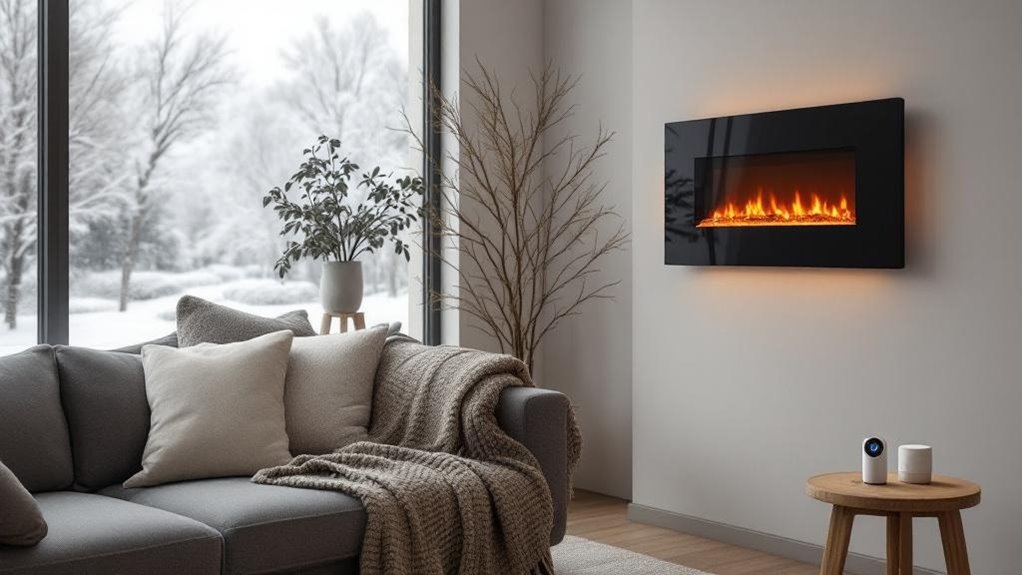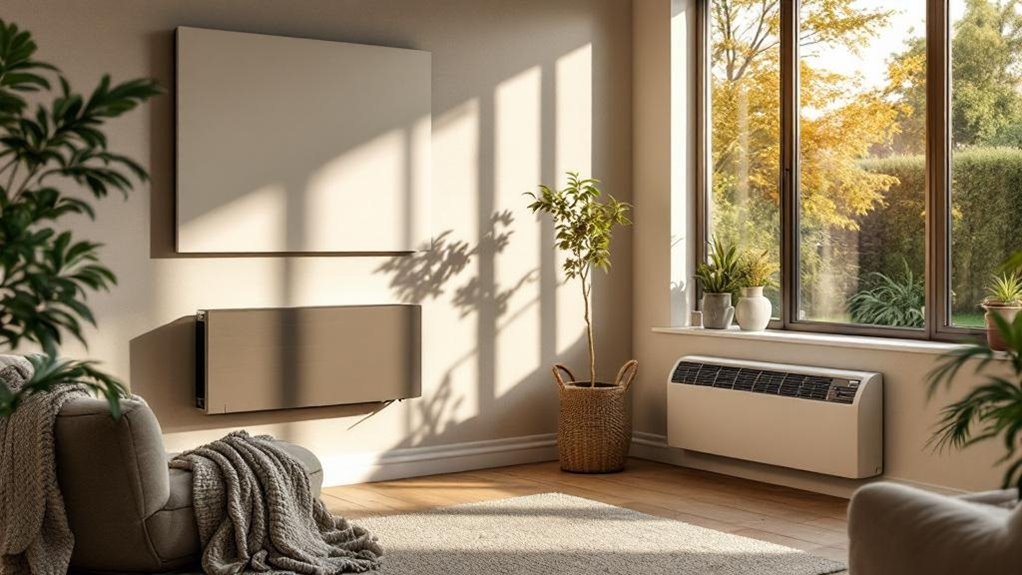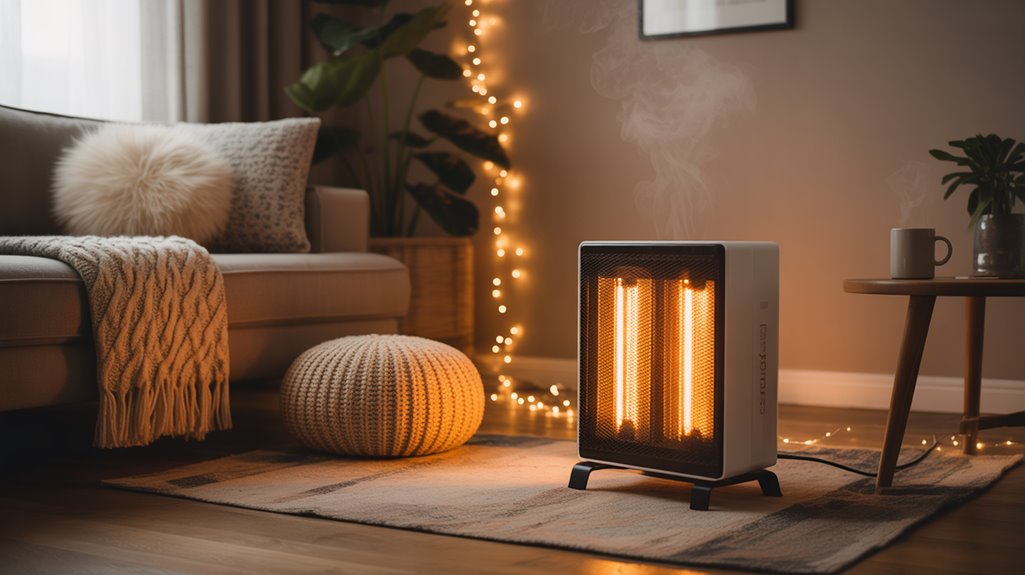I’ve been researching heating alternatives for my own home renovation, and I’ll share what I’ve discovered about replacing traditional fireplaces in 2025. The UK’s energy landscape is shifting dramatically, with new technologies offering genuine warmth without the maintenance headaches or soaring bills. From electric units that mimic real flames to bioethanol solutions requiring zero installation, these options solve real problems. Here’s why your next heating decision could save you hundreds while keeping you perfectly comfortable.
Key Takeaways
- Electric fireplaces offer plug-and-play installation with realistic LED flames, consuming 40-50% less energy than traditional heating methods.
- Bioethanol fires provide real flames without chimneys or regulations, perfect for contemporary homes seeking clean-burning efficiency.
- Heat pumps deliver 300-400% efficiency with £7,500 government grants available, cutting carbon emissions by 70% compared to gas boilers.
- Smart heaters integrate with home thermostats, offering real-time energy tracking, geofencing triggers, and maintenance alerts for convenience.
- Portable infrared panels and underfloor heating mats install quickly without permanent modifications, ideal for renters and rapid upgrades.
Electric Fireplaces: Modern Heat Without The Hassle

Electric fireplaces solve the heating dilemma that’s plagued homeowners for decades—you get the warmth and ambiance of a traditional fireplace without the chimney maintenance, ash cleanup, or ventilation headaches. I’ve watched these units evolve from basic space heaters to sophisticated heating solutions that rival traditional fireplaces.
Today’s electric fireplaces use infrared technology to distribute heat efficiently while LED flames create realistic visuals. You’ll find wall-mounted and freestanding designs that complement any décor. The plug-and-play installation means you won’t need professional setup—just connect and enjoy. Medium-sized units are particularly popular for both residential and commercial applications due to their versatility. Conducting a thorough property inspection before purchasing a home is crucial to avoid hidden defects.
With UK energy costs rising, these units consume 40-50% less energy than traditional heating methods. Smart integration lets you control temperature remotely, and you’ll reduce emissions by 99% compared to wood-burning alternatives.
Bioethanol Fires: Clean-Burning Fuel For Contemporary Homes
While electric fireplaces deliver convenience, bioethanol fires offer real flames with the clean-burning efficiency that contemporary homes demand. I’ll show you why they’re becoming the go-to choice for modern heating solutions.
You’ll skip the hassle of building regulations, chimneys, and flues entirely. Unlike wood burners facing £300–£1,000 fines in Smoke Control Areas, bioethanol fires operate restriction-free. They’re exempt from Ecodesign mandates and DEFRA certification requirements. Additionally, they do not contribute to increased energy consumption, making them a more economical choice compared to traditional heating methods.
Here’s what you need: 95–97.5% purity bioethanol exclusively—never gel fuels. Store bottles securely in cool areas. Guarantee proper ventilation through open windows or wall vents during operation.
You’ll maintain safe distances from flammable materials and follow manufacturer guidelines religiously. Position your fireplace on non-combustible surfaces for optimal safety and performance. Commercial users must comply with Health and Safety at Work Act standards for peak performance.
Energy Efficiency Breakthroughs Transforming UK Heating

Beyond clean-burning alternatives like bioethanol, the UK’s heating landscape faces a revolutionary shift driven by groundbreaking efficiency technologies. I’m seeing heat pumps deliver 300-400% efficiency while slashing your carbon emissions by 70% compared to gas boilers. You’ll benefit from £7,500 grants through the Boiler Upgrade Scheme, making the change affordable. Additionally, homes with improved Energy Performance Certificates are likely to see enhanced value and marketability as buyers increasingly seek energy-efficient options.
Modern electric radiators now feature AI learning that adapts to your schedule, eliminating duct heat loss entirely. If you’re not ready for full conversion, hybrid systems automatically switch between heat pumps and existing boilers based on demand.
Smart grid integration transforms your heating into a money-saving tool. Dynamic pricing synchronizes your system with low-cost energy periods, while cloud algorithms optimize performance using weather forecasts. You’re getting precise control that cuts waste. Starting in 2025, the Future Homes Standard will require all new constructions to install low-carbon heating systems, making heat pumps the standard choice for developers.
Cost-Saving Benefits That Add Up Over Time
Once you’ve invested in efficient heating alternatives, the real financial rewards unfold through compound savings that transform your energy bills year after year. I’ve seen households save £400-£550 annually through targeted upgrades, with these benefits compounding over 10-15 years.
Your loft insulation and heating controls become money-making machines – ECO4 measures alone generated £138.5 million in yearly savings by 2025. Heat pumps deliver the biggest long-term wins, saving you up to £7,000 over 15 years compared to gas boilers, thanks to their superior efficiency.
The numbers don’t lie: retrofit projects average £568 annual savings per property, while full policy rebalancing could slash your bills by £1,849 yearly. With the current price cap setting average annual bills at £1,849 for typical consumption, these savings represent substantial relief from today’s elevated energy costs. These aren’t one-time benefits – they’re persistent savings that grow stronger each year you avoid traditional heating costs.
Environmental Advantages Of Eco-Friendly Heating Solutions
As home heating generates 18% of the UK’s greenhouse gas emissions, switching to eco-friendly heating solutions delivers measurable environmental impact that extends far beyond your property boundaries.
I’ll show you how heat pumps transform your heating footprint by drawing 70-80% of their energy from renewable sources, dramatically reducing fossil fuel dependence. You’re joining a movement where the government targets 600,000 heat pump installations annually by 2028, ending new fossil fuel boiler installations by 2035. Additionally, implementing energy assessments before making changes can help identify the most effective improvements for your home.
Your eco-friendly heating choice directly supports the UK’s net zero commitment by 2050. I recommend pairing heat pumps with improved insulation – 54% of Energy Company Obligation measures focus on insulation because it amplifies your system’s efficiency. You’ll cut energy demand while contributing to national climate goals that require £162 billion in low-carbon heating investments. Heat pumps achieve 73% less carbon emissions compared to the most efficient boilers, making them a powerful tool for household carbon reduction.
Design Flexibility For Every Home And Budget
Whether you’re working with a cramped city flat or sprawling countryside estate, modern heating alternatives adapt to your specific space constraints and design vision. I’ve found electric underfloor heating transforms open-plan layouts without wall clutter, while compact electric boilers tuck neatly into utility closets. For tight budgets, infrared panels under £500 deliver zone heating and double as decorative mirrors or artwork.
If you’re retrofitting, air source heat pumps install externally with minimal structural changes. Media wall electric fires slot into entertainment units without construction hassle. Ground source heat pumps need extensive outdoor space but offer 50-year lifespans despite £18,000+ upfront costs.
Your aesthetic preferences matter too—electric fires provide multicolour flame effects, while pellet stoves offer sleek, programmable casings perfect for contemporary spaces. Additionally, incorporating timeless design elements like navy and white cabinetry can enhance the overall ambiance of your heating solutions.
Smart Technology Integration For Ultimate Convenience
While traditional fireplaces require you to fiddle with logs and matches, today’s smart heating alternatives let you control every aspect from your phone. I’ll show you how these systems transform your heating experience.
You can adjust flame intensity, customize colors, and schedule automatic shut-offs through dedicated apps. Voice control through Alexa or Google Home means you’re starting your fireplace before you even walk through the door.
The real game-changer? These systems sync with your home’s thermostat and track energy consumption in real-time. You’ll receive maintenance alerts, set up geofencing triggers, and save your favorite configurations as one-touch presets. Additionally, many of these smart heaters are designed to be cost-effective heaters that help lower your energy bills during colder months.
With child safety locks and overheating protection built-in, you’re getting convenience without compromising safety—exactly what modern homeowners deserve.
Installation Options For Renters And Homeowners
Smart heating systems offer incredible convenience, but your installation options depend entirely on whether you rent or own your property. If you’re renting, I recommend portable electric heaters and infrared panels with adhesive strips – they’ll give you warmth without risking your deposit. Electric fireplaces work brilliantly in existing openings, while freestanding ethanol units move wherever you need heat. As a homeowner, you’ve got more flexibility. Electric boilers can replace your gas system using existing radiators, and underfloor heating mats install in just 1-2 days. For long-term savings, consider air source heat pumps – they need external units but transform your heating costs. Smart electric radiators offer the perfect middle ground, connecting to WiFi without rewiring headaches. Additionally, incorporating modern design elements can enhance the overall aesthetic of your heating solutions.
Government Incentives Supporting Sustainable Heating Upgrades
Since the government expanded its Boiler Upgrade Scheme in 2025, you’ll find £7,500 grants available for air-source and ground-source heat pumps – that’s a significant jump from previous funding levels. I’ve noticed they’re also consulting on expanding coverage to include air-to-air heat pumps and heat batteries, giving you more sustainable options.
If you’re earning under £36,000 or receiving means-tested benefits, the Warm Homes Grant offers up to £30,000 for complete energy upgrades. Your property needs an EPC rating of D-G to qualify. Can’t afford upfront costs? They’re introducing leasing options and payment plans to spread expenses over years. With 18,000 new retrofitters being trained nationwide, installation capacity is scaling up fast, making your sustainable heating upgrade more accessible than ever. Additionally, understanding local market dynamics can help you choose the best sustainable heating options that align with property investment strategies.
Regional Trends Shaping UK Heating Choices In 2025
As climate patterns shift dramatically across the UK, I’m seeing heating choices evolve differently in each region based on local conditions and infrastructure. England’s battling acute heatwave threats, driving demand for dual-function heat pumps that’ll cool your home during scorching summers while heating efficiently in winter. Scotland and Wales are experiencing record sunshine, making air-source heat pumps increasingly viable with better performance ratios. Northern Ireland’s temperature spikes are pushing hybrid systems that combine renewables with backup heating. If you’re in coastal areas, prioritize humidity-resistant solutions like modern heat pumps over traditional radiators. Urban dwellers are embracing smart thermostats for heat island management, while rural communities lean toward biomass hybrids due to grid limitations. Your regional climate reality determines your best fireplace alternative. Additionally, incorporating energy-efficient appliances can significantly enhance your kitchen’s warmth while keeping costs low.
Conclusion
I’ve shown you nine game-changing heating alternatives that’ll slash your bills and boost your home’s comfort. You don’t need to stick with outdated, inefficient heating methods. Pick the solution that fits your space and budget—whether it’s an electric fireplace for instant warmth or a heat pump for long-term savings. Check government incentives, compare installation costs, and make the switch. Your wallet and the planet will thank you.
References
- https://www.elbfireplaces.co.uk/electric-fire-trends-for-2025-the-future-of-home-heating/
- https://www.imaginfires.co.uk/blog/future-of-home-heating/
- https://www.newforestfires.co.uk/new-year-new-fireplace-why-2025-is-the-perfect-time-to-upgrade-your-home-heating
- https://www.flames.co.uk/blog/top-fireplace-trends-for-2025.html
- https://jandhlogs.co.uk/blogs/j-h-blog/wood-burning-uk-home-heating-statistics
- https://www.cognitivemarketresearch.com/regional-analysis/europe-electric-fireplace-market-report
- https://www.marketresearchfuture.com/reports/electric-fireplace-market-20312
- https://www.mordorintelligence.com/industry-reports/europe-electric-fireplace-market
- https://www.stellarmr.com/report/Electric-Fireplace-Market/529
- https://www.6wresearch.com/industry-report/united-kingdom-uk-fireplaces-and-stoves-market-2020-2026

